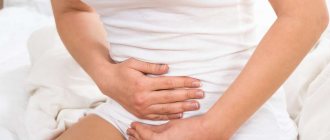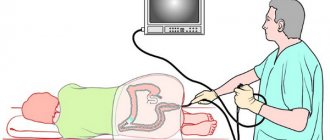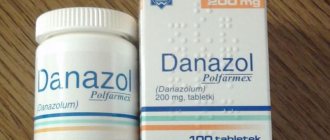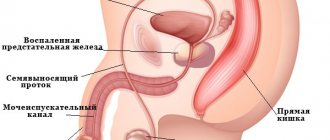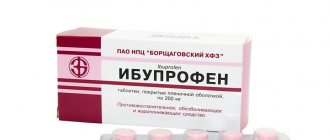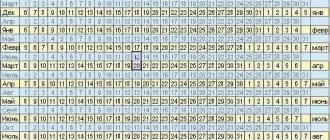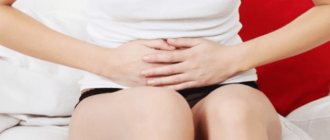Nagging pain in the lower abdomen in the middle of the cycle can occur for various reasons. Sometimes their appearance does not pose a danger to a woman’s health.
However, there are cases when the reasons why the lower stomach hurts are associated with serious diseases that should be treated immediately.
Let's figure out why girls face this?
Feature of the disease
Pain in the lower abdomen in the middle of the cycle is a problem that many women face.
Usually, it is insignificant, so many representatives of the fair sex prefer not to pay attention to it.
However, there are times when even at the beginning of the cycle a girl’s stomach feels very tight. Why is this happening?
The reasons for this phenomenon can be associated with both pathologies and the normal physiological functioning of the female body.
Since a woman is capable of reproducing, we can say that her body is more complex than a man’s.
This is why for many girls the processes of menstruation and pregnancy bring severe pain in the abdominal area.
https://youtu.be/qqBR_7hVDnI
What happens in a woman's body in the middle of her cycle?
The middle of the cycle is the period of ovulation in women, the most favorable time for conceiving a child. For some, this moment passes without any unpleasant sensations, while others complain of aching and nagging pain in the lower abdomen and lumbar region. This symptom is physiological and does not pose a health hazard. During ovulation, in addition to nagging pain, a woman is characterized by the following conditions:
- copious white discharge resembling egg white;
- small amounts of bloody or brownish fluid;
- slight increase in body temperature to +37.1…+37.3°C;
- aching pain in the lower abdomen and lower back, as during menstruation.
During ovulation, the follicle ruptures, releasing follicular fluid, accompanied by the release of brown mucus. Most often, women notice streaks of blood. This phenomenon is not always regular, and for some it is completely absent. If a woman first discovers blood in the middle of her cycle, there is no need to worry about this, but she should visit a gynecologist.
Unpleasant sensations during this period are completely natural; most often they are aching and nagging pains, very similar to those that women experience during menstruation. Sometimes they can be cutting or stabbing. This state of the body lasts from several hours to two to three days. Lower back pain is also a normal mid-cycle symptom. The reason for this is still the same - the egg leaves the ovary, and the nerves become irritated.
If the pain is unbearable and lasts more than three days, then you should immediately consult a specialist, as this may be a symptom of serious health problems (appendicitis, ectopic pregnancy, cyst rupture). Another cause of brown discharge is pregnancy. During conception, the egg attaches to the wall of the uterus, and a small amount of the endometrium (the inner lining of the uterus) is shed.
Gynecological factors
Pain in the lower abdomen in the middle of the cycle can be associated with female sexual health.
If a girl has identified a connection between the occurrence of discomfort and her sex life, she is recommended to undergo a gynecological examination.
Many women who have any gynecological ailments have a tummy tuck not only in the middle, but also at the beginning of the cycle. In this case, the lady should pay attention to the presence of other symptoms.
Perhaps she feels nauseous, vomits, and in the morning she discovers strange vaginal discharge. It is important to diagnose a gynecological disease in time, as otherwise it may have complications.
When is urgent medical attention needed?
A woman needs to consult a doctor as soon as possible or call an ambulance if she notices the following symptoms:
- body temperature rises steadily;
- pulls the lower back in the middle of the cycle for a long period of time (more than 24 hours);
- feeling sick, feeling the urge to vomit;
- the ovary constantly hurts, the patient’s condition continues to deteriorate;
- a woman may suddenly faint;
- bleeding occurred (regardless of the intensity of the discharge);
- the patient has undergone gynecological operations or diseases of the reproductive system in the past;
- the ovaries hurt while taking medications to stimulate ovulation.
Problems with women's health, even if they seem completely harmless and insignificant, should be addressed by a specialist. Self-medication is strictly prohibited! This can result in serious problems for a woman. At best, they may be related to the functioning of the reproductive system. Some pathologies can threaten the patient’s life and require emergency surgery.
https://youtu.be/qsGuhLJwFPA
Ovulation
Frequent pain in the lower abdomen in the middle of the cycle can be explained by ovulation. Why does the girl feel discomfort?
The bottom of her stomach may hurt because during ovulation the egg is released into the abdominal cavity.
When does this happen? This phenomenon occurs only in the middle of the cycle, that is, on about 14-15 days. As for the duration of pain, it is different for all women.
Discomfort in the lower stomach can be felt from several hours to several days. However, for some girls, the lower abdomen does not feel tight or painful at all during ovulation.
If a woman’s menstrual cycle is accompanied by some pathological process, the pain may not go away for several days.
In most cases, the intensity of discomfort during ovulation is moderate.
During sexual intercourse, a girl's lower abdomen may hurt more than usual. Why is this happening?
The causes of discomfort during sexual intercourse during ovulation are associated with hormonal changes in a woman. This phenomenon also occurs due to the process of blood redistribution.
If there is severe discomfort during ovulation, a woman should inform her gynecologist. Perhaps the causes of pain are related to the disease.
Causes of pain after ovulation
To understand why the lower abdomen feels tight after ovulation, you need to understand the process itself and its effect on the female body.
Every month, vesicles called follicles form in the ovaries. At a certain moment, one of them accelerates in development, while the rest gradually fade away and disappear. An egg matures in a large follicle. The duration of its development until full maturity is different for each. On average 11-17 days. When it is ready, the follicle “explodes” and the cell descends into the fallopian tube. Here, upon meeting the sperm, it is fertilized and continues on its way to the uterus. Attaching to its wall indicates a successful conception.
A mature egg ruptures the follicle. Because of this, during ovulation the lower abdomen pulls
At this time, on the wound of the ovary, from where the cell emerged, the corpus luteum begins to mature. Its function is to produce a hormone that allows the fertilized cell to develop properly. In addition, the hormone contributes to the entire process of pregnancy and is produced throughout the entire period.
If no sexual intercourse took place at the time of ovulation, the cell dies within a day or two. The ovary is gradually healing and preparing for a new cycle. This stage is the same for everyone – 14 days. Very rarely it can have a shorter duration - up to 11-12 days.
Thus, when the lower abdomen feels tight after ovulation, the reasons are quite obvious. A rupture of the ovarian wall occurs, which is accompanied by unpleasant sensations. But it’s worth noting that some people don’t feel it or don’t pay attention. This pain is not always obvious. This depends on the pain threshold of the woman herself and on some internal processes.
For others, on the contrary, after ovulation, the lower abdomen and lower back pull quite strongly. There's no need to worry. This phenomenon occurs and is explained by the girl’s greater sensitivity to pain. The side on which the pain is felt indicates the ovary that produced the cell. They are known to work in turns. But sometimes, one of them may miss the line due to a failure caused by stress or infection. Climate change could have a similar impact. All these reasons affect, by the way, the speed of ovulation. They are quite capable of moving this moment, even with a usually rhythmic cycle.
Pulling in the lower abdomen after ovulation - what could be the reasons?
Pregnancy
Pain in the abdominal area at the beginning of the cycle may be a sign that the girl will soon become a mother.
Some women mistakenly believe that discomfort in the first trimester of pregnancy may indicate its pathological course. In fact, moderate discomfort during this period is an absolutely normal physiological phenomenon.
For what reason does pain occur? The factor that causes them is an enlarged uterus, which puts pressure on the internal organs. The growth of the uterus depends on the development of the fetus. The larger the child becomes, the more intense the pain will be.
As for women who have already become mothers, in their case, discomfort will be felt less.
When a girl’s receptors are compressed due to an enlarged uterus, discomfort occurs not only in the stomach, but also in the lumbar region.
It is impossible to say that unpleasant sensations during pregnancy will prevent the expectant mother from functioning in society. Over time, she will become accustomed to this new state for herself.
What happens in a woman's body in the middle of her cycle?
The middle of the cycle is the period of ovulation in women, the most favorable time for conceiving a child. For some, this moment passes without any unpleasant sensations, while others complain of aching and nagging pain in the lower abdomen and lumbar region. This symptom is physiological and does not pose a health hazard. During ovulation, in addition to nagging pain, a woman is characterized by the following conditions:
- copious white discharge resembling egg white;
- small amounts of bloody or brownish fluid;
- slight increase in body temperature to +37.1…+37.3°C;
- aching pain in the lower abdomen and lower back, as during menstruation.
During ovulation, the follicle ruptures, releasing follicular fluid, accompanied by the release of brown mucus. Most often, women notice streaks of blood. This phenomenon is not always regular, and for some it is completely absent. If a woman first discovers blood in the middle of her cycle, there is no need to worry about this, but she should visit a gynecologist.
Unpleasant sensations during this period are completely natural; most often they are aching and nagging pains, very similar to those that women experience during menstruation. Sometimes they can be cutting or stabbing. This state of the body lasts from several hours to two to three days. Lower back pain is also a normal mid-cycle symptom. The reason for this is still the same - the egg leaves the ovary, and the nerves become irritated.
If the pain is unbearable and lasts more than three days, then you should immediately consult a specialist, as this may be a symptom of serious health problems (appendicitis, ectopic pregnancy, cyst rupture). Another cause of brown discharge is pregnancy. During conception, the egg attaches to the wall of the uterus, and a small amount of the endometrium (the inner lining of the uterus) is shed.
Why does brown discharge occur in the middle of the cycle? Why might bleeding occur in the middle of the cycle? Why does women experience pain in the lower abdomen, localized on the left?
Age characteristics
In the middle or at the beginning of the cycle, pain that occurs in the abdominal area may be associated with the woman’s age.
As you know, adolescence is characterized by an unstable menstrual cycle. Consequently, unstable cycle length can cause pain.
Hormonal disruptions in the teenage female body also contribute to discomfort before menstruation.
If a girl does not have any gynecological health problems, then, over time, she will “outgrow” this problem.
Psycho-emotional stress
Stress is what provokes a number of diseases. Discomfort in the stomach during the premenstrual period can be caused by stress.
The fact is that prolonged psycho-emotional stress in which a person lives negatively affects the functioning of his gastrointestinal tract.
When a girl worries about something significant to her for several days, she may encounter such unpleasant problems as nausea, stomach pain or belching.
The causes of these ailments are nervousness. Therefore, to get rid of these problems, you need to distance yourself from the irritant as much as possible. Also, in this case, relaxation therapy will be useful.
Stomach hurts after ovulation - what to do
If everything is fine in a woman’s body, there are no chronic diseases or other problems, then, most likely, the pain after ovulation will go away within two to three days. But if the pain lasts more than three days, you need to visit a gynecologist. Be sure to focus your attention on the following problems and tell your gynecologist about them:
1. How long do you feel the pain, how severe is it.
2. Where exactly is the pain localized?
3. Are you experiencing pain for the first time or has it been going on for several months in a row. This is an important point that you must pay attention to.
4. Does the temperature rise along with the pain. If the mark on the thermometer exceeds 37.8, then most likely you are experiencing an inflammatory process.
5. Are there other symptoms? Perhaps, along with the pain, nausea and dizziness occur.
Only after a thorough examination will the doctor be able to prescribe you the correct treatment - hormonal or painkillers.
Pregnancy is not the most common reason why your stomach may hurt after ovulation. In this case, of course, no treatment is required, because your baby is developing, and pain and other signs are normal. But what if pain after ovulation occurs for other reasons?
Almost every 5 women experience a stomach ache after ovulation has passed. Immediately after a feeling of discomfort begins to arise, you must first calm down and relax. It is recommended to drink as much fluid as possible and measure your body temperature throughout the day to prevent the development of infections in advance. In order to get rid of pain, you can take medications such as paracetamol, ibuprofen.
In addition, hot baths or applying a hot heating pad can help relieve discomfort. Thanks to such actions, blood flow will be stimulated, the muscles will be able to fully relax. If you have been bothered by pain, nausea, vomiting, or diarrhea for several days, then under no circumstances should these symptoms be ignored.
You can prepare yourself in advance for the fact that painful sensations will soon come; for example, many people keep a diary where they write down all pain syndromes, the time of their occurrence and duration. If you supplement each such record with a medical history, as well as the examinations performed, you can identify the nature of the pain, its location, and then proceed with further treatment.
Some gynecologists prescribe laparoscopy. After the pain syndrome intensifies and a specialist detects abnormalities, you need to take an x-ray, as well as donate blood and urine for tests.
If certain diagnoses are confirmed, contraceptives may be prescribed that can suppress ovulation, and therefore relieve you of subsequent pain.
Diseases that cause illness
It should be remembered that, in itself, pain during the premenstrual period is not a separate disease. Rather, it is a symptom of the disease that indicates its presence.
What diseases provoke abdominal pain:
- Endometritis.
- Cystitis.
- Diverticulitis.
- Pyelonephritis.
- Chronic salpingoophoritis.
- Endometriosis.
- Intestinal pathologies.
- Anomalies in the development of the genital organs, etc.
What other signs of successful conception could there be?
The fetus tries to communicate its existence from the very first days of its existence. There are many of them, you just need to be able to notice them:
- Minor blood loss. They confuse girls who confuse them with menstruation. This symptom does not appear at the same time: it all depends on the structural features of the body. Usually the norm is 6-12 days. You can see drops of yellowish or brownish blood on your underwear. But here you need to be extremely careful - if the process lasts more than 3 days, rush to the gynecologist. Otherwise, there is a risk of involuntary abortion (miscarriage).
- A heaviness appeared in the lower abdomen. Discomfort appears in the pelvic area. These symptoms may appear in the first week. They indicate that the uterus has become hypersensitive, as well as changes that have occurred in it. Each body feels differently. Therefore, all patients named different pain thresholds. But almost all of them stated that during subsequent pregnancies the pain was much stronger.
- The breasts swelled and became more sensitive. This sign is characteristic of one of the stages of baby development. In the first week after fertilization has occurred, the breasts may become hypersensitive. Pain is also considered normal. But this sign is not mandatory. Some ladies claimed that in the first week after the birth of the fetus, no sensations were observed.
- Malaise, general weakness. Problems with well-being and bad mood can often accompany pregnancy. Immunity deterioration is also possible.
- Symptoms:
- slight malaise
- drowsiness
- rapid fatigue
- weakness
- Irregular menstruation (delay). Sometimes it is possible that menstruation occurs in 1 month of pregnancy, since up to 15 days the fertilized egg may not yet reach the uterus. But a repetition in the 2nd month indicates that there is a problem and you need to go to the doctor.
- Toxicosis. One of the first signs signaling that a miracle has occurred.
Algomenorrhea
What is algodismenorrhea? This is a condition in which a woman experiences pain during the menstrual and premenstrual periods.
In most cases, the discomfort in this condition is cramping in nature.
Most women prefer to deal with pain with the help of appropriate medications. Many people take antispasmodic drugs in an attempt to relieve discomfort.
If the girl does not have any gynecological pathologies, then after taking antispasmodics, algodismenorrhea goes away.
If the pain syndrome in this condition cannot be relieved with any medication, the woman should undergo a gynecological examination.
As practice shows, algodismenorrhea appears several days before the onset of menstruation.
For some women, severe discomfort in the lower part of the stomach appears only on the first day of menstruation, but there are those for whom it does not go away even on the fourth day.
Postovulatory syndrome and methods for its elimination
After the ovulation period, the ruptured follicle, which released a mature egg, closes and fats and a certain luteal pigment begin to form in it. In this way, the uterine cavity prepares to receive the embryo.
The period of formation of the “corpus luteum” begins - a unique temporary organ that ensures the production of necessary hormones, in particular progesterone, which contributes to a successful pregnancy.
If you exclude the possibility of conception, pain may be associated with postovulatory syndrome. According to statistics, every fifth or sixth woman after ovulation has a tummy tug, as before menstruation, and this amounts to about 15-20% of the entire female population of the planet who are ready to bear children.
During this period, a woman may experience the following symptoms:
- pain in the lower part of the body, pulling or sharp, tingling;
- weakness, which may result in a slight decrease in performance;
- sudden mood swings and emotional instability;
- possible increase in sexual libido;
- uncharacteristic vaginal discharge.
Symptom relief
- To make the postovulatory period as pleasant as possible, you can use some recommendations. For example, a warm bath can help relieve unpleasant symptoms. At the same time, the muscles of the torso and the whole body will relax, thereby reducing pain.
- You can add a few drops of essential oils to lift your mood or, conversely, calm you down.
- A warm heating pad or water bottle can also help relieve soreness if you place it on your stomach and lie there for a while.
- If this option is not very suitable, you can take painkillers. But you should be careful when taking them, since painful sensations can be “signs of pregnancy in the early stages.”
What features does discomfort have with algodismenorrhea?
- It can be localized in the perineal area.
- His character is tugging and griping.
- It is accompanied by weakness and malaise.
Along with discomfort during the premenstrual period, a girl may experience other symptoms, namely:
- Increased sweating.
- Nausea.
- Intestinal disorder.
- Headache, etc.
As for such a symptom as intestinal upset, it should be noted that during bowel movements a girl may experience severe pain. What is this connected with?
During the premenstrual and menstrual periods, the uterus increases in size, which is why it begins to put pressure on the intestines.
This leads to a woman having a frequent urge to defecate. Moreover, she may experience such an urge even if her intestines are empty.
Pathological conditions
- Infection. If the genitals are infected, in addition to stomach discomfort, a woman will face problems such as foul-smelling vaginal discharge, burning and itching.
- Hypothermia. If a girl is hypothermic, she runs the risk of catching a cold in her ovaries.
- Neoplasms in the body. Pain in the stomach can be caused by benign and malignant tumors.
- Chronic disease of the reproductive system.
- Ovarian rupture.
- Hormonal disbalance. Hormonal disruption occurs due to the physiological characteristics of the body.
- Spikes.
